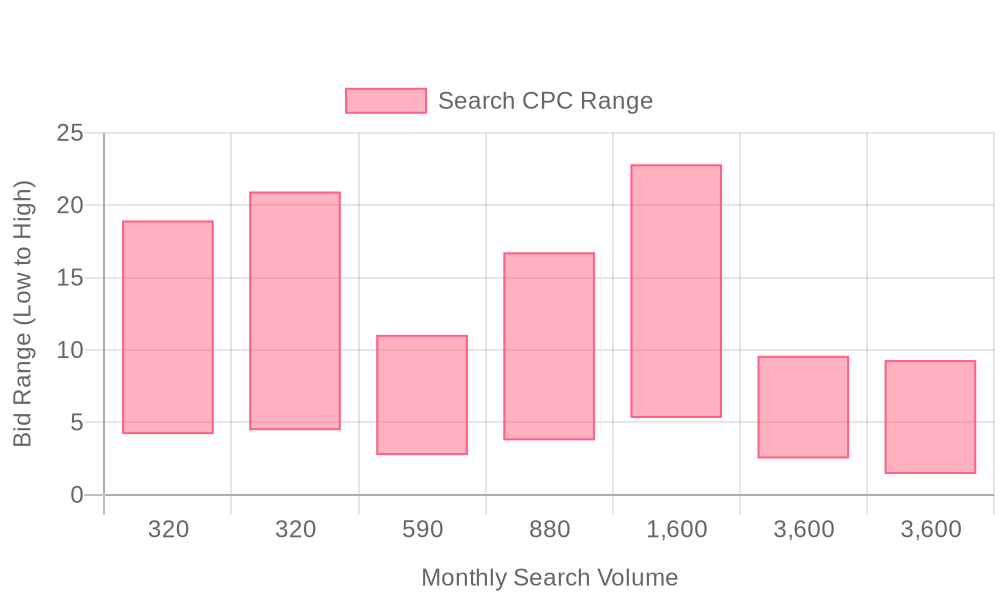
Supercharge your lead generation with a FREE Google Ads audit - no strings attached! See how you can generate more and higher quality leads
Get My Free Google Ads AuditFree consultation

No commitment
Supercharge your lead generation with a FREE LinkedIn Ads audit - no strings attached! See how you can generate more and higher quality leads
Get My Free Google Ads AuditFree consultation

No commitment
Supercharge your lead generation with a FREE Meta Ads audit - no strings attached! See how you can generate more and higher quality leads
Get My Free Google Ads AuditGet My Free LinkedIn Ads AuditGet My Free Meta Ads AuditFree consultation

No commitment
Supercharge your lead generation with a FREE Google Ads audit - no strings attached! See how you can generate more and higher quality leads
Get My Free Google Ads AuditFree consultation

No commitment
In today's competitive landscape, effectively using Google Ads for cancer insurance campaigns is crucial. The stakes are high—not only because of the sensitivity of the topic but also due to strict advertising regulations. Online channels like Google Ads allow you to intercept potential customers at their moment of need, offering a direct bridge between awareness and action. With growing numbers of users researching insurance options online, missing pivotal moments when prospects don't fill out contact forms is a significant challenge. Modern solutions now allow businesses to identify potential leads even when a form isn't submitted, enhancing follow-up and conversion rates. Here, we delve into the strategic use of Google Ads to enhance cancer insurance marketing efforts while addressing common challenges and maintaining ethical considerations.

Effective lead generation for cancer insurance demands a balance of regulatory compliance, sharp targeting, and immediate engagement. The right approach not only attracts a qualified audience but also ensures every interested party receives prompt, relevant communication that keeps your brand front of mind—while leveraging intent signals to prioritize high-potential leads.
The insurance market, especially for cancer coverage, faces high competition and strict ad policies. Success hinges on understanding intent-based targeting, optimizing your campaign structure, and connecting your CRM and advertising workflows to prevent missed opportunities and wasted budget.
Understanding Google Ads for cancer insurance begins with a focus on compliance and strategic audience building. Certification for health insurance advertising is non-negotiable: all campaigns must meet Google’s verification requirements, ensuring your ads display only after appropriate documentation and approval. For step-by-step instructions, review how to check your Google Ads health insurance certification. This provides not only legal protection but also builds trust with prospects who expect transparency from insurance providers.
Once certified, marketers can leverage advanced targeting options that align with healthcare advertising policies. Demographic, geographic, and contextual targeting allow campaigns to reach users actively seeking cancer insurance, without violating restrictions related to sensitive health conditions. By analyzing in-market behaviors and audience data, teams can allocate spend to keywords and audiences with the strongest conversion potential, avoiding unqualified clicks and unnecessary spend.
Immediate follow-up is critical in insurance lead generation. When a prospect submits an inquiry, real-time routing to sales or service teams prevents leads from cooling off. Integrating tools that unify visitor identification and sync enriched audience data directly into your CRM and ad platforms streamlines this process, ensuring no opportunity slips through the cracks. Automated workflows can trigger personalized responses or retargeting, helping maintain momentum and move prospects through the funnel efficiently. To see how streamlined identification and automation can transform your results, get started for free with Sona.

Cancer insurance buyers conduct extensive research online, often at critical decision points. Google Ads reaches these users at the moment they demonstrate intent, making it an essential channel for driving high-quality leads and educating prospects about coverage options.
Precision targeting in Google Ads enables cancer insurance providers to connect with individuals who are actively seeking protection against the financial burden of a cancer diagnosis. With real-time audience insights, marketers can align ad delivery with user intent and optimize spend toward audiences most likely to convert.
Automation further streamlines campaign management by dynamically segmenting audiences as they progress through the buyer’s journey. Modern platforms enable marketers to identify and prioritize visitors showing strong in-market signals, ensuring that budgets are maximized toward accounts exhibiting high engagement. If you’re ready to capture more qualified leads and simplify your workflow, get started for free with Sona.
Unified data workflows allow for seamless integration between ad platforms, CRM systems, and attribution models. This ensures every interaction, from the first click to policy purchase, is captured and analyzed, offering a true picture of campaign ROI and supporting ongoing optimization for insurance lead generation.

Cancer insurance marketers benefit from a diverse set of Google Ads campaign formats, each aligned to a specific phase in the buyer journey. Selecting the right campaign type helps maximize lead generation, brand visibility, and conversion rates while maintaining compliance in a highly regulated space. By combining these approaches with precise audience intelligence and real-time data integration, teams can identify engaged prospects quickly and route them to the most relevant follow-up. If your organization is ready to capture more qualified leads, get started for free with Sona.

Modern growth in the cancer insurance sector depends on unearthing channels that extend beyond legacy advertising and outdated lead databases. Revenue teams that harness unified market intelligence can quickly spot and capitalize on new demand pockets, while gaining a sharper view of buyer intent.
Disconnected intent data often leaves sales teams guessing about lead quality and readiness. By consolidating web, ad, and CRM signals, marketers can distinguish between casual researchers and true in-market buyers. For a breakdown of how digital marketing strategies for health insurance drive lead generation, review recent research for industry insights. This unified approach enables more precise targeting and smarter resource allocation, directly increasing insurance lead generation and campaign ROI. With advanced attribution and dynamic audience updates, teams continually refine their approach to capture emerging growth opportunities as the cancer insurance market evolves.
Ready to boost your insurance lead generation? Get started for free with Sona.

Precision in audience segmentation significantly elevates the performance of cancer insurance campaigns, transforming generic outreach into meaningful, data-driven engagement. Segmentation enables marketing teams to deliver tailored experiences that mirror the complex needs of each buyer, resulting in higher lead quality and stronger pipeline momentum. By leveraging audience intelligence, marketers can identify previously anonymous website visitors and connect them to account records, empowering sales teams with richer data for more relevant outreach.

| Industry | Keyword | Monthly Search Volume | Competition Level | Low Bid | High Bid |
| Cancer Insurance | best life insurance for cancer patients | 320 | MEDIUM | 4.2 | 18.94 |
| Cancer Insurance | life insurance for cancer survivors | 320 | LOW | 4.47 | 20.94 |
| Cancer Insurance | cancer insurance policy | 590 | MEDIUM | 2.75 | 11.05 |
| Cancer Insurance | life insurance with cancer | 880 | MEDIUM | 3.77 | 16.74 |
| Cancer Insurance | life insurance for people with cancer | 1600 | MEDIUM | 5.31 | 22.82 |
| Cancer Insurance | cancer insurance | 3600 | MEDIUM | 2.52 | 9.6 |
| Cancer Insurance | aflac cancer policy | 3600 | MEDIUM | 1.44 | 9.31 |
A robust keyword strategy for cancer insurance advertising is essential for capturing high-intent prospects while maintaining compliance with healthcare advertising policies. The right keywords ensure visibility among individuals actively researching coverage options, claims processes, and financial planning related to cancer. By prioritizing terms with clear purchase intent, marketers improve both cost efficiency and lead quality. For deeper insights into compliant keyword selection, explore this overview of Google’s health insurance ad policies.
**Strategic Use of Keywords**: Building your campaign around highly specific queries such as "how to choose cancer insurance," "cancer insurance claims process," and "cancer policy benefits" positions ads in front of searchers deep in the consideration or decision stage. These keyword choices reflect direct user needs, making each click more likely to convert. Incorporating long-tail variations like "compare cancer insurance plans 2024" and "best cancer insurance for families" helps reduce wasted spend and reach buyers with nuanced requirements. To identify and prioritize high-value website visitors ready to convert, leverage Sona Identification.
**High-Intent Audience Targeting**: Advances in digital marketing now allow revenue teams to move beyond basic demographics. By analyzing real-time search and browsing signals—such as repeated visits to coverage comparison pages or frequent engagement with insurance calculators—teams can prioritize budgets for those showing purchase intent. Dynamic audience lists automatically update as prospects engage across the funnel, ensuring only the most qualified leads see your ads.
**Negative Keywords**: Filtering out irrelevant or low-intent queries is just as critical as finding the right targets. Adding negative keywords like "DIY," "free advice," "job openings," or "cancer cure alternative" keeps campaigns focused on users genuinely seeking insurance solutions, not unrelated information. This approach not only preserves ad budget but also ensures compliance by avoiding prohibited or misleading health-related terms. For additional guidance, consult this step-by-step guide for compliant Google healthcare ads.
Aligning your keyword approach with ongoing campaign measurement and CRM integration enables marketers to sync enriched audiences, attribute conversions accurately, and rapidly adjust messaging to fit shifts in buyer intent. This unified data flow results in more precise targeting, higher return on investment, and streamlined insurance lead generation. If you’re ready to transform your approach, get started for free with Sona and see how advanced data-driven tools can elevate your cancer insurance campaigns.
Robust keyword targeting is fundamental for Google Ads for cancer insurance. Start with core cancer-related insurance phrases, such as "cancer insurance policy," "critical illness cover," and "cancer financial protection," then layer on geo-modifiers like city or state names to localize campaigns and improve lead quality. Integrate negative keywords to filter out irrelevant or non-converting traffic, which reduces wasted spend and sharpens your audience focus. For more insight into optimizing ad spend, explore top PPC strategies for health insurance companies.
Audience segmentation becomes more powerful when you leverage intent data to detect companies and individuals most likely to engage. By connecting ad platforms with precise audience intelligence, marketers can identify anonymous website visitors, reveal which organizations are researching cancer insurance options, and tailor keyword lists to match emerging buyer intent signals. This approach ensures that ad budgets are spent on high-propensity accounts that are actively in-market, maximizing both relevance and conversion rates.
Effective ad copy for health insurance advertising must speak directly to the pain points of individuals seeking cancer coverage. Use clear language to highlight benefits such as "immediate lump-sum payouts," "no medical exam required," or "flexible payment plans." Trust signals, like "licensed by state regulators" or "24/7 support," build confidence and lower barriers to engagement.
Incorporate dynamic elements powered by real-time audience insights so your messaging reflects the prospect's position in the funnel. As audiences move from research to decision, ad text can automatically adjust to emphasize urgency, new offers, or exclusive resources. Syncing enriched CRM data with Google Ads allows for more precise personalization, ensuring each touchpoint is relevant and timely, which drives higher engagement and improved insurance lead generation outcomes.
Landing pages for Google Ads for cancer insurance must align 1:1 with ad keywords and address core client concerns without distraction. Each page should present a concise value proposition, answer common questions, and use testimonials or accreditations to validate claims. Keep forms short and focused—request only essential information to reduce friction and encourage completion.
Enhance the customer journey by connecting behavioral data from ad clicks with on-site activity. Unified data platforms can track which landing pages convert best for specific audiences and keywords, then dynamically adjust content or CTAs based on previous interactions. This level of optimization ensures the message remains consistent and personalized from ad impression through to lead capture, increasing both the quality and volume of conversions.
Continuous optimization is essential in healthcare marketing. Monitor conversions, click-through rates, and audience engagement at every stage, then use those insights to refine bids, adjust budgets, and update targeting parameters. Platforms that unify sales and marketing data deliver advanced analytics, surfacing which campaigns and keywords drive the most valuable leads and providing actionable recommendations in real time. For a detailed overview of compliance and campaign planning, see Google’s health insurance ad policies.
Integrate online and offline conversion tracking to build a complete view of ROI. By syncing closed-loop data back into your ad platform and CRM, you can attribute policies sold or consultations booked directly to specific ads and keywords. This granular attribution model empowers revenue teams to double down on the highest-performing tactics, shift spend to emerging segments, and automate retargeting with up-to-date audience lists that reflect where each lead stands in the purchase journey. This approach drives smarter, faster decisions, and ensures every marketing dollar is fully accountable.
Cancer insurance providers face unique challenges in reaching new markets and building trust among at-risk populations. Strategic expansion depends on educational outreach, precise targeting, and the ability to continuously refine campaigns based on unified, actionable data.
Disjointed systems and siloed data often slow expansion efforts and obscure true ROI. Integrated analytics bridge these gaps by providing revenue teams with a single source of truth for campaign performance. This empowers marketers to attribute offline conversions, identify high-intent visitors, and dynamically update audience lists as prospects engage across touchpoints, all of which accelerate insurance lead generation and policy sales growth. Ready to streamline your expansion? Get started for free with Sona.
Navigating the dynamic landscape of Google Ads for promoting cancer insurance demands a strategic approach that aligns with advertising policies and effectively targets potential customers. It's crucial to understand how to utilize Google Ads to maximize reach while maintaining compliance and relevance in your campaigns.
Throughout this article, we've explored the core challenges of advertising cancer insurance, such as navigating policy restrictions and identifying the right audience. We've also discussed key strategies like keyword optimization, demographic targeting, and crafting compelling ad copy that resonates with your target market. By implementing these strategies, you can enhance your ad performance and drive meaningful engagement.
You're on the brink of transforming your ad campaigns into powerful tools that not only comply with regulations but also effectively connect with those who need your products most. With the right insights and tools, the possibility of reaching and impacting your audience becomes not just a goal but a reality. Harness the power of data-driven strategies to elevate your marketing efforts and make a genuine difference.
To fully realize this potential and see tangible results, start for free and experience how our platform can elevate your ad strategy and performance. This is your opportunity to take control and drive success in your marketing endeavors.
All campaigns must meet Google’s verification requirements for health insurance advertising, ensuring your ads display only after appropriate documentation and approval.
To create compliant ads, ensure you are certified for health insurance advertising, adhere to Google's healthcare advertising policies, and use precise targeting while maintaining transparency and compliance.
Effective strategies include using intent-based targeting, optimizing campaign structure, leveraging demographic and geographic targeting, and integrating CRM with advertising workflows.
Budget allocation should focus on high-intent keywords and audiences, optimize spend towards audiences likely to convert, and minimize waste through precise targeting and negative keywords.
Avoid missing compliance certification, unoptimized keyword strategies, lack of real-time follow-up on leads, and failure to integrate ad platforms with CRM systems for seamless data flow.
Join results-focused teams combining Sona Platform automation with advanced Google Ads strategies to scale lead generation

Connect your existing CRM

Free Account Enrichment

No setup fees
No commitment required

Free consultation

Get a custom Google Ads roadmap for your business
Join results-focused teams combining Sona Platform automation with advanced Meta Ads strategies to scale lead generation

Connect your existing CRM

Free Account Enrichment

No setup fees
No commitment required

Free consultation

Get a custom Google Ads roadmap for your business
Join results-focused teams combining Sona Platform automation with advanced LinkedIn Ads strategies to scale lead generation

Connect your existing CRM

Free Account Enrichment

No setup fees
No commitment required

Free consultation

Get a custom Google Ads roadmap for your business
Join results-focused teams using Sona Platform automation to activate unified sales and marketing data, maximize ROI on marketing investments, and drive measurable growth

Connect your existing CRM

Free Account Enrichment

No setup fees
No commitment required

Free consultation

Get a custom Google Ads roadmap for your business
Over 500+ auto detailing businesses trust our platform to grow their revenue
Join results-focused teams using Sona Platform automation to activate unified sales and marketing data, maximize ROI on marketing investments, and drive measurable growth

Connect your existing CRM

Free Account Enrichment

No setup fees
No commitment required

Free consultation

Get a custom Google Ads roadmap for your business
Over 500+ auto detailing businesses trust our platform to grow their revenue
Join results-focused teams using Sona Platform automation to activate unified sales and marketing data, maximize ROI on marketing investments, and drive measurable growth

Connect your existing CRM

Free Account Enrichment

No setup fees
No commitment required

Free consultation

Get a custom Google Ads roadmap for your business
Over 500+ auto detailing businesses trust our platform to grow their revenue
Our team of experts can implement your Google Ads campaigns, then show you how Sona helps you manage exceptional campaign performance and sales.
Schedule your FREE 15-minute strategy sessionOur team of experts can implement your Meta Ads campaigns, then show you how Sona helps you manage exceptional campaign performance and sales.
Schedule your FREE 15-minute strategy sessionOur team of experts can implement your LinkedIn Ads campaigns, then show you how Sona helps you manage exceptional campaign performance and sales.
Schedule your FREE 15-minute strategy sessionOur team of experts can help improve your demand generation strategy, and can show you how advanced attribution and data activation can help you realize more opportunities and improve sales performance.
Schedule your FREE 30-minute strategy sessionOur team of experts can help improve your demand generation strategy, and can show you how advanced attribution and data activation can help you realize more opportunities and improve sales performance.
Schedule your FREE 30-minute strategy sessionOur team of experts can help improve your demand generation strategy, and can show you how advanced attribution and data activation can help you realize more opportunities and improve sales performance.
Schedule your FREE 30-minute strategy sessionOur team of experts can help improve your demand generation strategy, and can show you how advanced attribution and data activation can help you realize more opportunities and improve sales performance.
Schedule your FREE 30-minute strategy session





Launch campaigns that generate qualified leads in 30 days or less.
